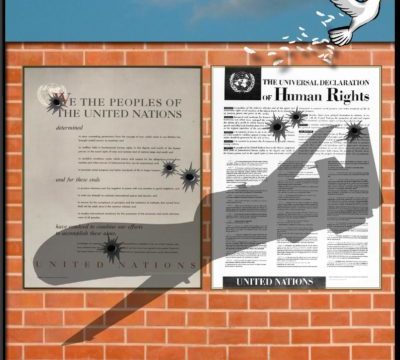Dr. Jackline Nyerere
Senior Lecturer of Educational Leadership and Policy Kenyatta University – KENYA
Introduction
A 2018 UNHCR report encourages host countries to integrate children seeking refugee in their countries into their national education systems at all levels (UNHCR, 2018a). Educating refugee seekers at higher levels especially has been found to equip the learners with requisite skills to rebuild their home countries even as it helps them to heal from the trauma of displacement. The 1951 Refugee Convention defi nes a refugee as someone who ‚owing to a well-founded fear of being persecuted for reasons of race, religion, nationality, membership of a particular social group or political opinion, is outside the country of his nationality, and is unable to, or owing to such fear, is unwilling to avail himself of the protection of that country‘.
The push to have refugees educated is informed by the realisation that education enables individuals to thrive (ONE, 2016). Citing Filippo Grandi, the UN High Commissioner for Refugees, “Refugees have skills, ideas, hopes and dreams, are resilient and creative, with the energy and drive to shape their own destinies, given a chance” (UNHCR, 2016a).
Educating refugees in a developing country
It is estimated that about 30% of the world’s refugees are housed in the world’s least developed countries. Many countries in the Horn of Africa are experiencing some form of conflict which has led to displacements and a rise in the number of people seeking refugee status in the neighbouring countries. Kenya is one such country that hosts refugees from neighbouring Somalia, South Sudan and Ethiopia (UNHCR, 2016a). As a refugee host, the country is 10th largest in the world and comes at number 4 in Africa – after Uganda, Ethiopia, and the Democratic Republic of Congo (https://reliefweb.int/report/kenya/refugee-economies-kenya). The number of refugees in Kenya is approximately 475 412, out of which 259 100 persons come from Somalia. Note that this number has fallen since 2015, at which time the number of refugees from Somalia stood at 418 913. South Sudan contributes 116 172, the Democratic Republic of Congo 41 784, and Ethiopia 27 857. Of these, 209 979 are based in Dadaab, while 188 513 refugees are housed at Kakuma camp. The rest have been integrated into the urban centres across the country.
It is no doubt that refugees face several challenges in their quest for education and these challenges are more pronounced for those who are hosted in developing countries. These refugees certainly require more as they progress through levels of education, and the higher they move, the more luxurious it becomes even for the nationals to access due to resource
constraints (UNHCR, 2018b). This is notwithstanding the numerous benefits of refugee education that include opportunities to become leaders in their communities back home, to create businesses and social enterprises when they return, and build infrastructure that will almost certainly be non-existent on the return, and to act as peace ambassadors. The possibility of bringing lasting peace in the region through university education has been recognised as one of the weapons that universities can use (Sawahel, 2019).
Refugee education in Kenya
Kenya’s neighboring countries – Somalia and South Sudan, two countries that have seen years of confl ict, positions it as a host of refugees in the region. More than half of those fleeing conflict in the horn of Africa, and seeking refugee in Kenya are within 0–18-year age bracket and thus requiring learning opportunities. The country, working with the UNHCR and various partners, is providing both basic and tertiary education to these young refugees within her borders. Tertiary education is provided through one centre in Kakuma and four centres in Dadaab, the biggest of the two refugee camps (https://www. unhcr.org/ke/education).
Additionally, the country has a dedicated university campus in Dadaab refugee camp. The campus was established by Kenyatta University, one of the largest public universities in Kenya. Establishment of the campus was motivated by the country’s position as a host to a considerable number of school-going age refugees. The move to open the university campus was lauded by a section of stakeholders among them the UNHCR. During the official opening of the campus, UNHCR’s head of operations, Dominik Bartsch pointed out that the campus stood a chance to “serve as an incentive for refugee children to complete school and proceed to obtain higher qualifi cations” (UNHCR, 2012). He affi rmed that a university degree for refugees provided them with opportunities to help rebuild their countries once they returned, and to play the role of peace ambassadors. The Kenyatta University Daadab Campus targets mainly the refugees at the camp, as well as the local students.
The targeted refugees who have had a chance to acquire basic education and are seeking to further their education welcomed the opening of the campus, which they saw as an opportunity to achieve their dreams. One prospective student who had been seeking an opportunity to access higher education, Mohamed Bashir Sheik, a Somali refugee in Daadab camp expressed his joy at the opening of the campus saying that he planned to apply for admission. In his words, ‚I’m a journalist, and I’ve never attended a single training [session] or workshop… I want to go to Kenyatta University and study mass communications. I’m going to register’.
Other institutions offering higher education at the camp include Borderless Higher Education for Refugees (BHER) which delivers programmes in collaboration with academic institutions drawn from Kenya and Canada. In Kakuma, Strathmore University and Masinde Muliro University of Science and Technology offer training through e-learning and face-to-face delivery modes (UNHCR, 2016b).
The emergence of internationalisation of education and particularly regionalisation, where more and more students now study in countries that share borders means that some of the students in Kenyan universities come from the neighbouring countries. A recent study on students academic mobility in Africa that is yet be published showes that many of the ‚international students in Kenyan universities come from Somalia and South Sudan. These students, even though not refugees at the refugee camps, seek education in Kenya partly because of confl ict that has affected the development of education in their home countries. For instance, one of the students from South Sudan, taking a bachelors degree at Kenyatta University main campus said that ‚I chose to study in Kenya because of poor educational development in my home country for so many years, and I had been doing my studies in Kenya since the class (grade) eight up to now‘. Again some of the students had previously gone through the Kenyan education system at basic levels when they were refugees. One international student from Somalia explained his choice and reasons for studying in Kenya as follows I chose KU because I lived in Kenya as a child due to confl ict at home so studying here feels like home. … I want to learn here so that I can also improve my country.
Conclusion
Investment in refugee education in Kenya certainly follows the advice of UNHCR’s ‚it is vital that governments and higher education institutions provide more schemes allowing refugees to attend universities under the same conditions as nationals‘ (UNHCR, 2016a, p.39). Establishment of Daadab campus, for instance, allows refugees an opportunity to acquire a higher education degree that would prepare them for life back home. The refugees in Kenya are integrated in the Kenya education system right from basic to higher levels. With enhanced partnerships, refugees in the horn of Africa could acquire higher education that would help them rebuild their countries and develop infrastructure that has been ruined over the years due to conflict.
References
ONE. (2016, July 26). The importance of refugee education. Retrieved from https://www.one.org/us/blog/the-importance-of-refugee-education/
Sawahel, W. (2019, July 14). Universities aspeace-builders. University World News, 246.
UNHCR (2018a). The New York Declaration for Refugees and Migrants. Retrieved from https://www.unhcr.org/en-us/comprehensive-refugee-response-framework-crrf.html
United Nations High Commissioner for Refugees (UNHCR). (2018b). Turn the tide: Refugee education in crisis. Retrieved from https://www.unhcr.org/5b-852f8e4.pdf
United Nations High Commissioner for Refugees (UNHCR). (2016a). Missing out: Refugee education in crisis. Retrieved from http://uis.unesco.org/sites/default/fi les/documents/missing-out-refugee-education-in-crisis_unhcr_2016-en.pdf
United Nations High Commissioner for Refugees (UNHCR). (2016b). Global trends: Forced displacement in 2015. Retrieved from http://www.unhcr.org/ statistics/unhcrstats/576408cd7/unhcr-global-trends-2015.html
United Nations High Commissioner for Refugees (UNHCR). (2012, October 10). Top Kenyan university opens campus next to world’s largest refugee camp. Retrieved from https://www.unhcr.org/news/latest/2012/10/507570199/top-kenyan-universityopens-campus-next-worlds-largest-refugee-camp.html











